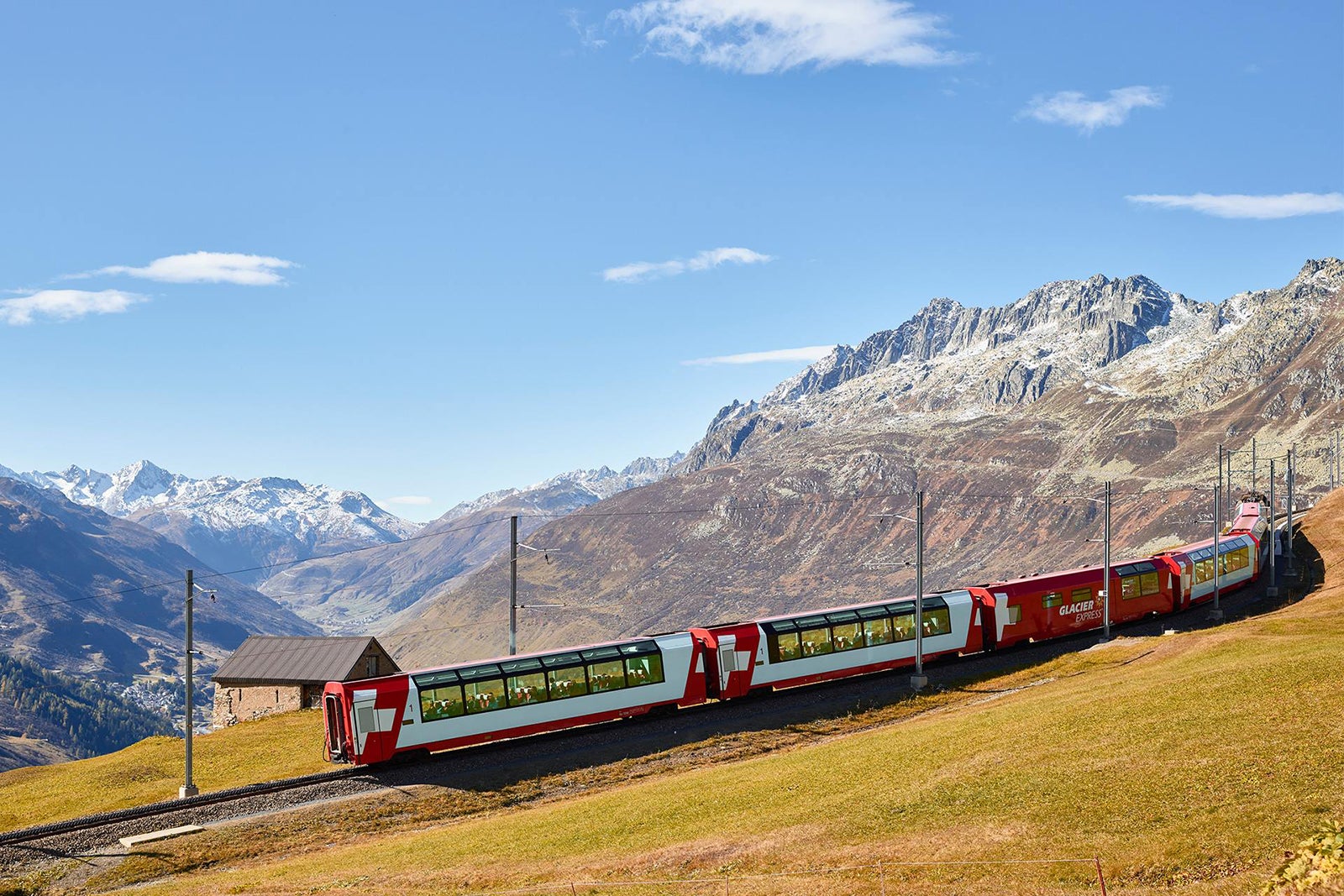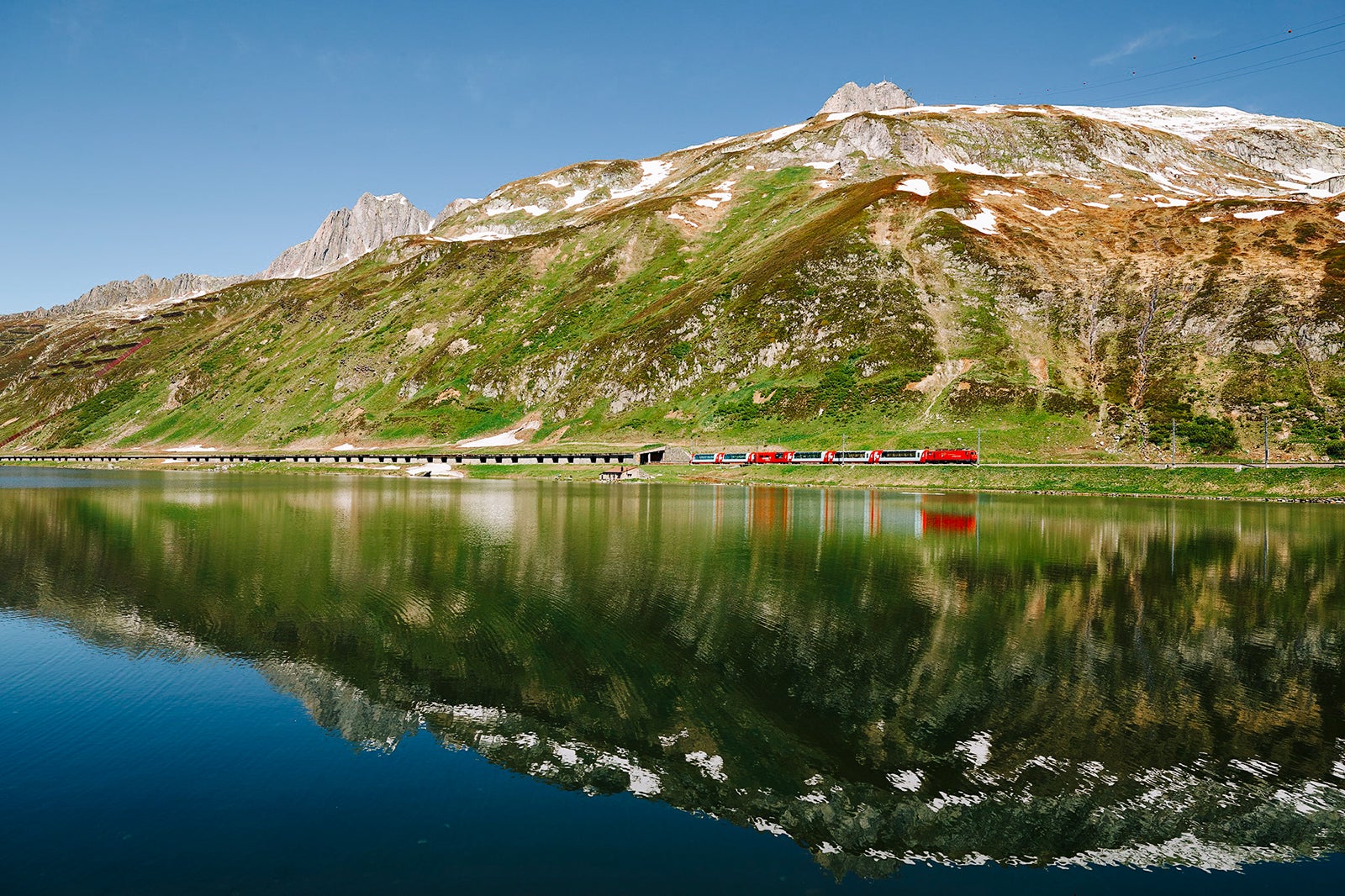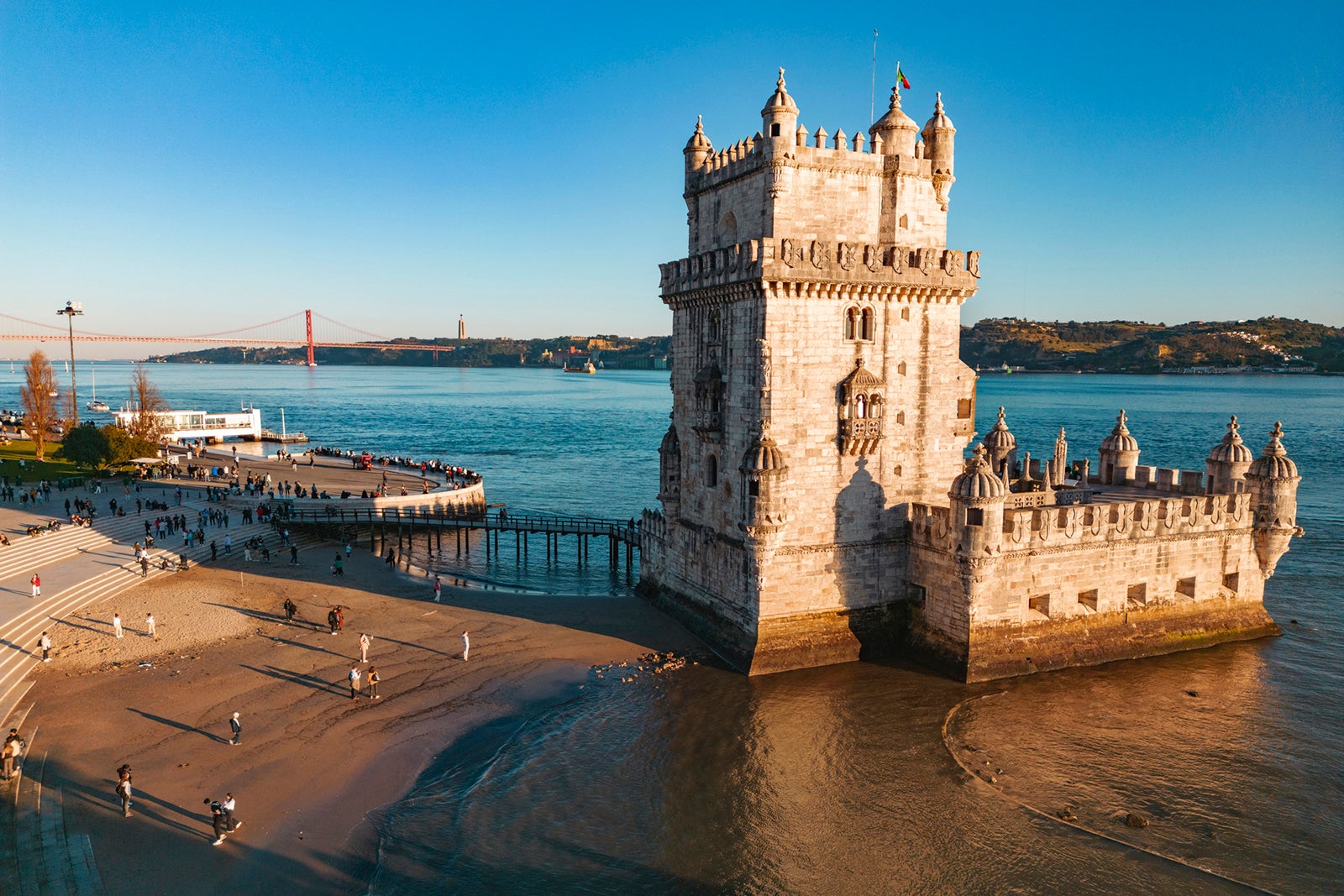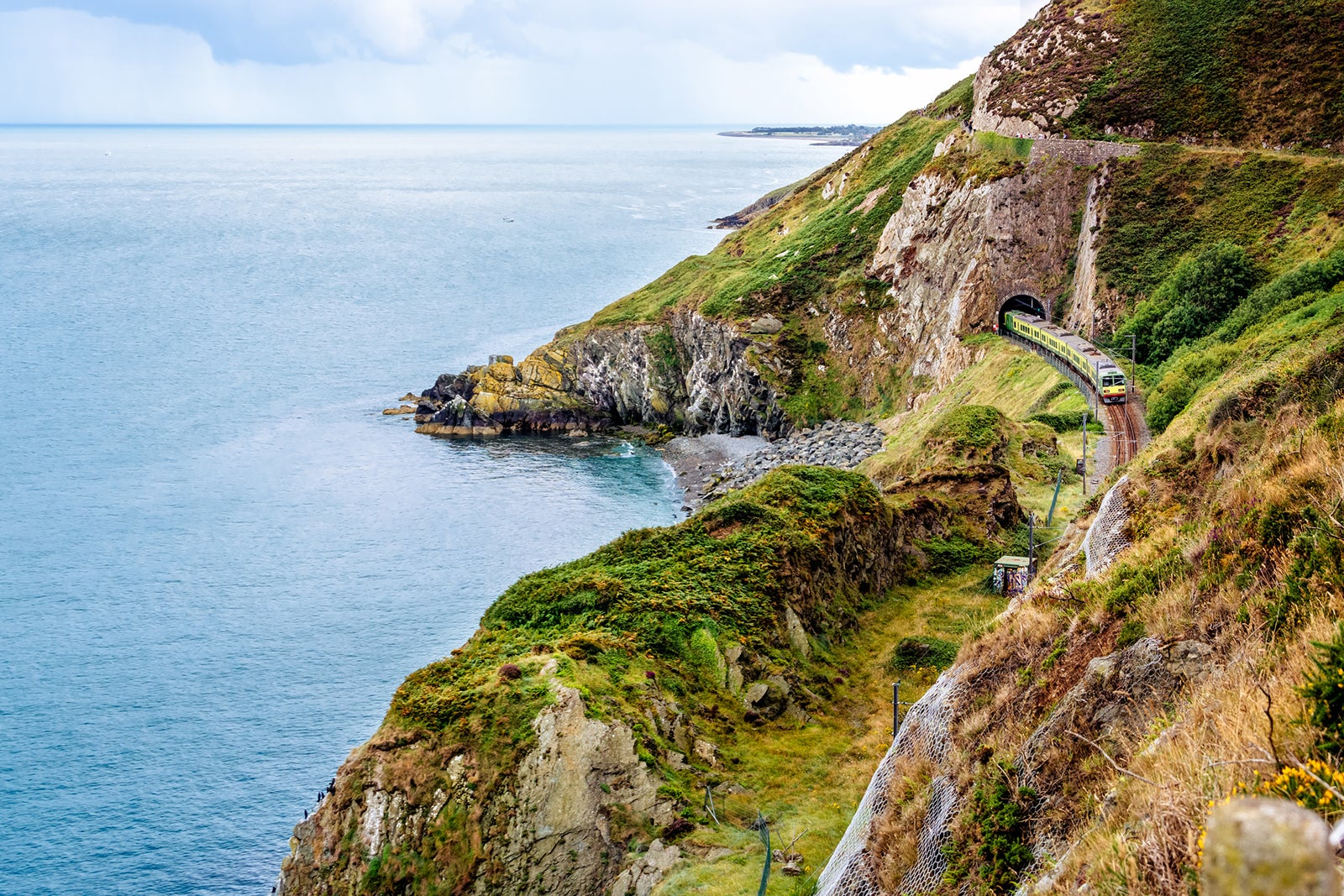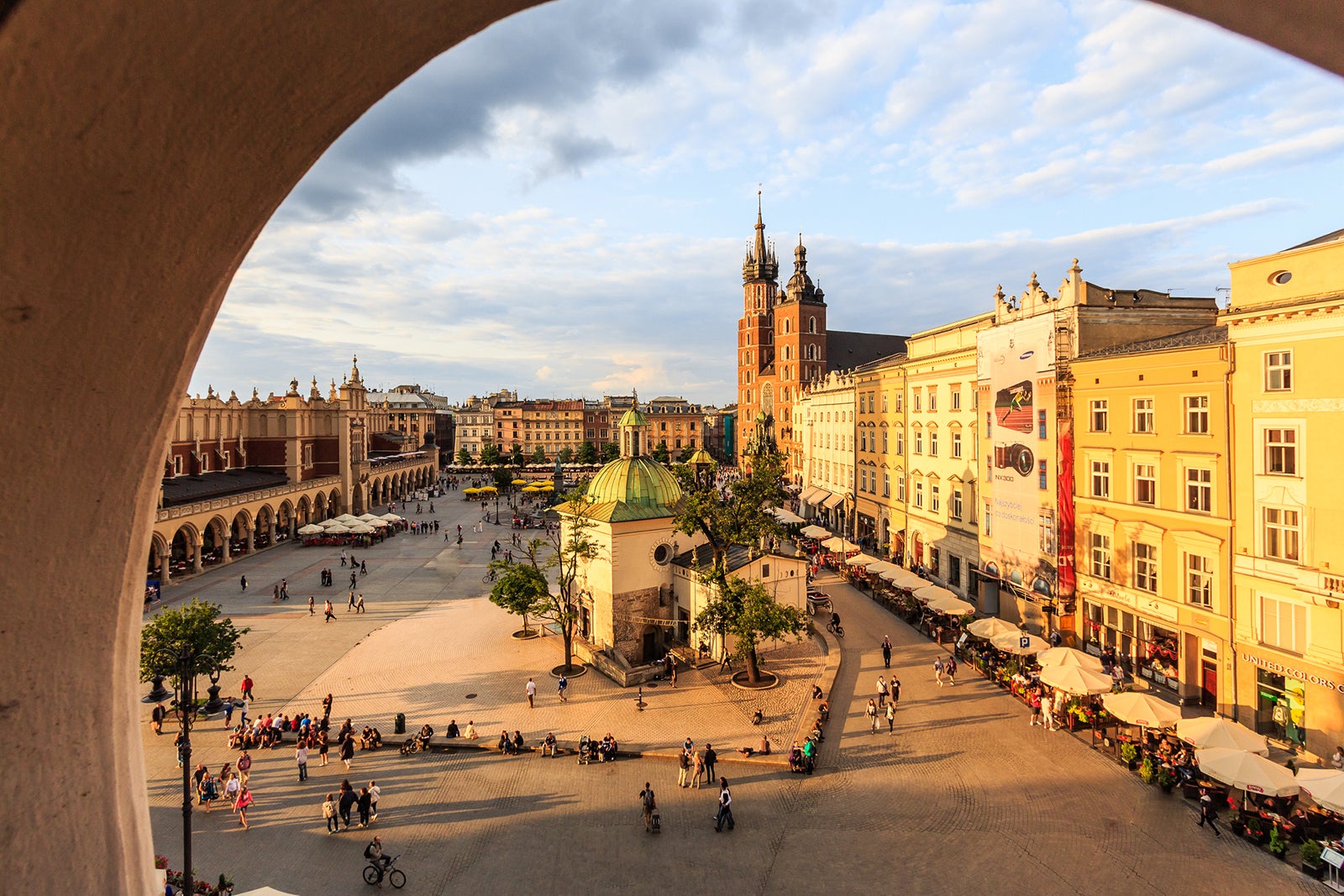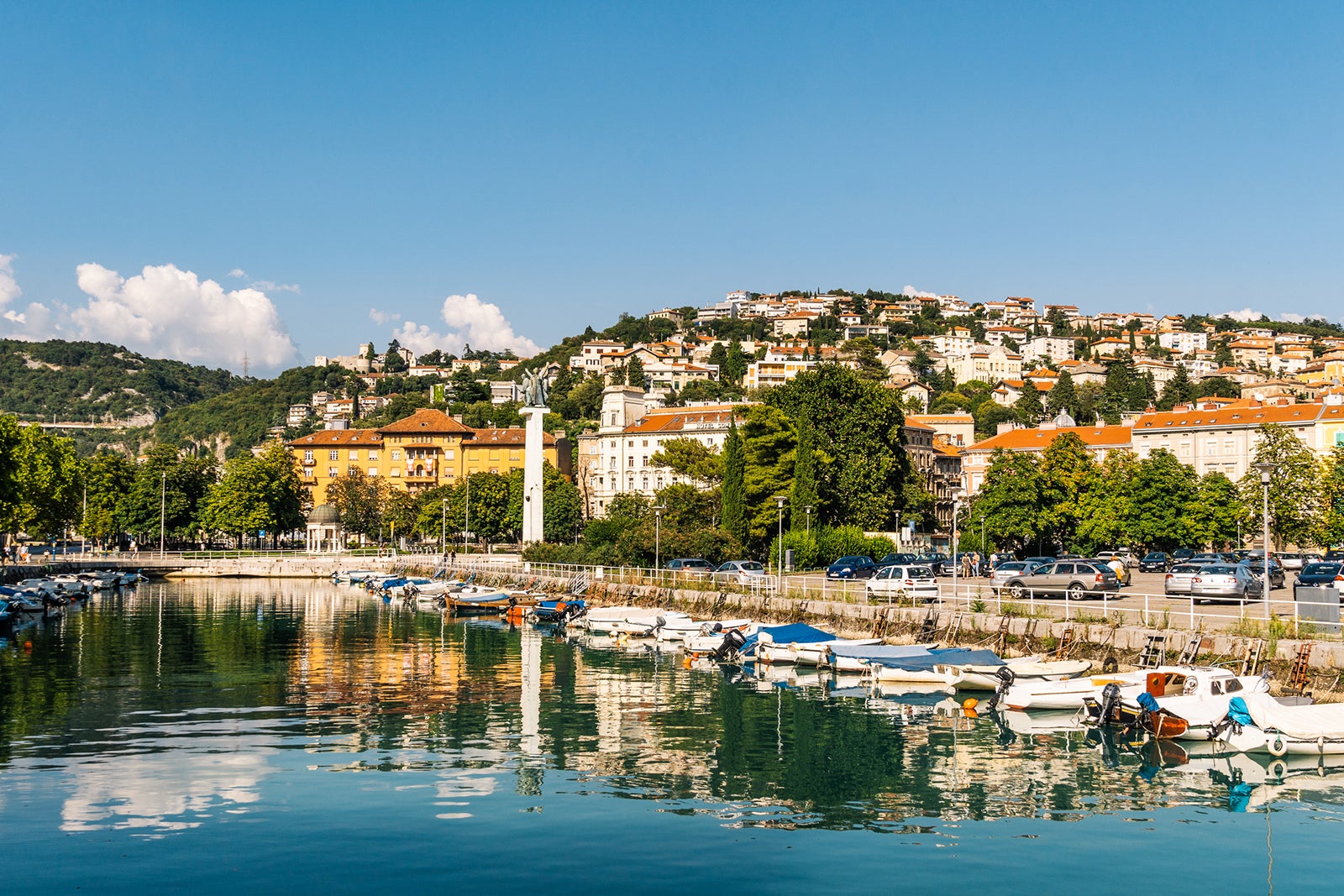As you gaze awestruck through the window at a skyline of jagged, ice-capped peaks or point excitedly as a world-famous landmark looms ahead, it hits you — epic views like these are meant to be savored, and there’s no better way to do that than from the window of a train.
This summer, European train travel has even more appeal, as you can skip past long rental car lines, duck high gas prices and arrive at your destination relaxed and rested while your fellow travelers suffer the stress of the road. Not to mention the fact that traveling by train helps you contribute to the health of the planet or, at least, minimize your impact on it from travel.
So, raise a glass of wine or frosty limonada, take in the melody of the humming rails and congratulate yourself on traveling in classic, time-honored style. Here are five train trips worth planning a European vacation around.
St. Moritz to Zermatt, Switzerland
The legendary Glacier Express lives up to its name, winding its way through some of the highest peaks in the Alps on the seven-hour trip from St. Moritz to Zermatt. Along the way, the line traverses 291 bridges and ducks through 91 tunnels as it climbs 6,000 feet to the foot of the Matterhorn.
On the first leg alone, you’ll cross the 200-foot-high Landwasser Viaduct along with a host of other engineering feats so marvelous that this stretch of track, known as the Albula railway line, is a UNESCO World Heritage Site. If you have time, it’s worth breaking up the journey with a stop in Chur, Switzerland’s self-styled oldest town, with 5,000 years of history stored in its stone-paved alleys and plazas dotted with colorful flower boxes.
After the initial part of the journey, you’ll make your through the Rhine Gorge, where the train streaks alongside the tumbling currents through a chasm so deep and narrow that much of it is inaccessible except by rail, before continuing up over the Oberalp Pass, the route’s highest point. Red-shuttered chalets, weathered barns, goats and sheep tinkling their bells in green meadows — you’ll be looking for Heidi and her herd around every bend.
Once in Zermatt, you’ll learn everything you ever wanted to about the drama and tragedy surrounding the first ascent of the legendary peak at the Matterhorn Museum, and you can ride the Gornergrat Railway partway up the peak itself. One of the numerous designated car-free villages in Switzerland, Zermatt is a pleasure to walk around, with shops and restaurants clustered along and around the Bahnhofstrasse.
Jokes about clockwork aside, Switzerland’s trains are as precise, pristine and predictable as the stereotype implies, with clear signage and instructions to help you navigate the well-designed network of routes that access nearly all parts of the country. The Glacier Express’ Excellence Class entitles you to a guaranteed window seat in a luxurious lounge-style chair with high-touch service and multicourse dining.
Tickets from St. Moritz to Zermatt start at 159 Swiss francs ($174) for adults and 79.50 Swiss francs ($87) for children ages 6 to 16. Rides are free for those under 6.

Daily Newsletter
Reward your inbox with the TPG Daily newsletter
Join over 700,000 readers for breaking news, in-depth guides and exclusive deals from TPG’s experts
Lisbon to Porto, Portugal
Start your Portuguese adventure in Lisbon, where you’ll want to walk the walls of the Castelo de Sao Jorge and lose yourself in the mazelike alleys of the Alfama district that surrounds the castle, whether you’re visiting for a day or five. Don’t miss Belem, a UNESCO World Heritage Site famed for its 16th-century Manueline architecture characterized by delicate stonework. Wander the cloisters of the Jeronimos Monastery, and visit the Belem Tower, an imposing structure on the bank of the Tagus River.
From Lisbon, a daytrip by train takes you to the seaside village of Cascais, now known for its beaches and fresh seafood dishes like monkfish stew and sardinhas assadas (sea salt-sprinkled grilled sardines). Here, the lavish mansions of Portuguese nobility have become museums, such as the Museu Condes de Castro Guimarães, where the former owner’s ornate silver candelabra, Moorish ceramics, illuminated manuscripts and somber portraits are displayed in elegant rooms with inlaid floors and coffered ceilings. Nearby, the Farol de Santa Marta overlooks one end of the harbor, while on the other side across from the lighthouse lies the fortress once known as Nossa Senhora da Luz, which has been transformed into the Citadel Art District, housing a luxury boutique hotel called Pestana Cidadela de Cascais, as well as a cafe, a restaurant and a gallery.
Another side trip not to be missed is the mountain village of Sintra. It’s virtually studded with palaces and castles, including the Pena Palace, a favorite photo-op thanks to its crenelated red and yellow towers and the crumbling stone ruins of the eighth-century Castelo do Mouros. Other stops include the National Palace, the Monserrate Palace and its botanical gardens, and the eerie Quinta da Regaleira, a gargoyle-studded Gothic mansion built by a wealthy eccentric.
Departing from Lisbon’s central Oriente station, the Alfa Pendular to Porto takes just under three hours, making a stop in Coimbra. Home to the country’s oldest university and birthplace of six Portuguese kings, including the country’s first ruler, Alfonso I, Coimbra is worth a visit to see the founding ruler’s tomb at the Santa Cruz Monastery and check out the ornate library, Biblioteca Joanina. If you overnight in Coimbra, take in an evening of traditional folk music at the Fado ao Centro.
With its entire central historic district listed as a UNESCO World Heritage Site, Porto is all about strolling and admiring the variety of architectural styles. Keep an eye on the azulejos, beautiful tilework that often features rich blue hues. Stunning views can be found from the bell tower of the Clerigos Tower if you can manage its 240 steep steps. If you have time, walk across the Ponte de Dom Luís I, the longest-spanning metal bridge in the world when it was completed in 1886; it connects Porto’s historic city center with the port industry’s warehouses and tasting rooms in Vila Nova de Gaia.
On that side of the river, artisan booths line the banks of the Douro and crowds throng the World of Wine, a 420,000-square-foot complex built in a cluster of formerly abandoned warehouses, cask storehouses and tanks. In addition to several of Porto’s hottest restaurants, WoW features seven interactive museums devoted to different aspects of wine making, history and culture, a wine school and a chocolate factory with paired tastings.
Perched high atop a steep hillside overlooking the port district, The Yeatman Hotel houses one of Porto’s best spas, designed to mimic a traditional European bathhouse with a marble hammam, a Roman bath, saunas, steam showers and hydrotherapy pools. An outdoor infinity pool overlooks the waterfront and features underwater porthole windows that are particularly fun for kids, who can make faces at each other through the glass.
No trip to Porto is complete without a visit to the wine country of the Douro Valley. Take the Douro Line (Linha do Douro) from Porto to Regua, which passes through 20 tunnels and over 30 bridges to navigate the rugged terrain. Taste the region’s storied vintages during a stop in Pinhao.
Tickets from Lisbon to Porto start at 17 euros ($18) each way for adults and 8.50 euros ($9) for children ages 3 to 13. Rides are free for kids younger than 3.
Dublin to Rosslare, Ireland
The Irish Rail trip from Dublin to Rosslare Europort in County Wexford starts with a clang moments after you depart Connolly Station and cross the River Liffey on a wrought-iron rail bridge … and that’s only the beginning. The journey around Bray Head winds through rock-hewn tunnels and along track that feels etched into the cliff high above the thundering surf. If you find yourself holding your breath, you’re in good company: The original route was so precarious that at one point, a train went into the sea and the line had to be rerouted. The engineering required to complete and maintain the route is so extreme that it gave rise to the sardonic nickname Brunel’s Folly after the ambitious Victorian railway engineer Isambard Kingdom Brunel who conceived and built it.
South of Bray, the trip takes you through a string of seaside villages, many of them still bustling with fishing boats and lobster pots. A commercial port known for its lively Saturday and Thursday fish markets, Wicklow has a rich history dating back to the Normans and the Vikings. Follow the Wicklow Town Heritage Trail to see where St. Patrick supposedly first landed on his return to Ireland and to learn about local figures like captain Robert Halpin, who laid the first telegraph cables between Europe and North America. While a jail might not normally top your list of sights, Wicklow’s features an interactive museum in the original prison building that narrates the stories of the men, women and, yes, even children imprisoned there under British rule.
Greystones, which takes its name from the stony coastline linking two beaches, features a quaint, walkable quayside lined with coffee shops and restaurants, while Arklow, once a center of boat building and one of the southern coast’s busiest ports, is quiet today with just a small cluster of fishing boats knocking against the pier. Highlights here include a Victorian tea room complete with scones and cream and a lavender farm outside town.
Following the River Slaney, the train trundles into Wexford, where the Irish National Heritage Park has installations showing what life was like in the area from the Stone Age through the 10th century and offers falconry demonstrations. From the line’s final stop, Rosslare Europort, you can expand your journey with a ferry ride to Wales, northern France or Bilbao, Spain.
Tickets from Dublin to Rosslare start at 27.50 euros ($30) one-way for adults and 12.40 euros ($13.50) for children and young adults from 5 to 19. Rides are free for children under 5.
Wroclaw to Krakow, Poland
It’s hard to decide whether elegant Krakow, with its walled Old City, historic Kazimierz Jewish Quarter and hilltop Wawel Royal Castle, is the centerpiece of this trip or if that honor goes to lively Wroclaw, where you’ll find a colorful market square, a gas lamp-lit historic district and an artsy neon yard. Divide your time between the two, which are connected by a three-hour journey, and leave extra days for Poland’s many other sights that are also easily accessible by train.
From Krakow, visit the otherwordly underground salt tunnels of Wieliczka, make a somber pilgrimage to the Auschwitz-Birkenau concentration camp and see the unusually large collection of vintage steam trains at The Chabowka Rolling Stock Heritage Park “Skansen.” In fact, when Steven Spielberg needed trains for “Schindler’s List,” he borrowed from the latter’s collection, which is housed in an old steam train depot.
While in Wroclaw, don’t miss sprawling Ksiaz Castle, which sits atop a maze of underground Nazi tunnels recently opened to the public. In Swidnica and Jawor, a UNESCO World Heritage Site protects two of the largest timber-framed churches in Europe. Both were built in the 1600s and feature elaborate wooden galleries.
An hour and a half from Wroclaw in the other direction astride the border with Germany, Gorlitz may look familiar. This German town served as the setting of “The Grand Budapest Hotel” and “Inglourious Basterds.”
Tickets from Wroclaw to Krakow start at 82 Polish zlotys ($22) for passengers ages 4 to 59 and 63 zlotys ($16) for seniors above 60. Rides are free for kids 3 and younger.
Trieste, Italy, to Rijeka, Croatia
You can have breakfast in Italy, lunch in Slovenia and feast on fresh seafood for dinner in Croatia thanks to the reopening of a long-shuttered train line linking these three neighboring countries on the Adriatic coast. Built at the height of the Austro-Hungarian Empire, the line between Trieste and Rijeka, Slovenia, was out of use for decades but reopened this spring for the summer season with plans to continue annual seasonal operations. With Croatia now part of the Schengen Area, it’s easy to hop on and off at any of the eight stops on the two-hour trip, which departs from Villa Opicina on the northern edge of Trieste.
Before leaving Trieste, make time to visit the fantastical Miramare Castle, a neo-Gothic mansion built by Austrian Archduke Ferdinand Maximilian. A good choice for lunch is the polyglot village of Ilirska Bistrica, which was passed among Italy, Germany and Yugoslavia before becoming part of Slovenia. It’s home to 40 watermills and miles of bike trails through verdant forests.
The tony resort colony of Opatija, Croatia, famed for its opulent 19th-century hotels and villas, makes a good choice for an overnight stop. Take an evening stroll along the 7-mile Lungomare seafront promenade and seek out the inlet marking the original harbor, Portic, where people gather to watch the sun set in front of the church of St. Jakov.
End your trip in Rijeka with visits to the Victorian glass-roofed fish market and the Sugar Refinery Palace, a local history museum housed in a repurposed sugar refinery.
Tickets from Trieste to Rijeka, which can be purchased at the station or on board, range from about $7 to $12, depending on the stops you make.

